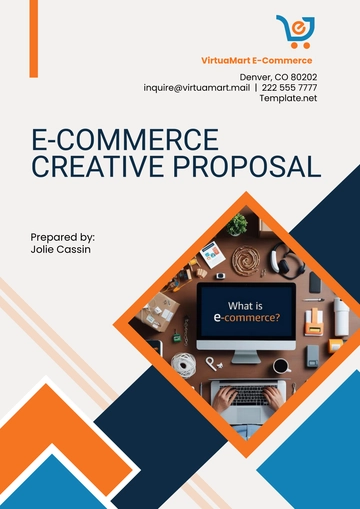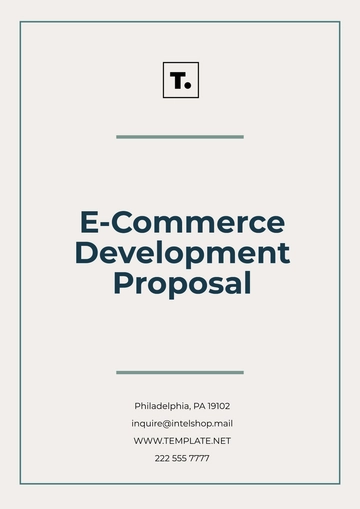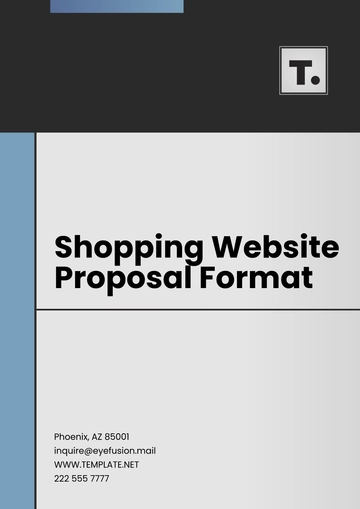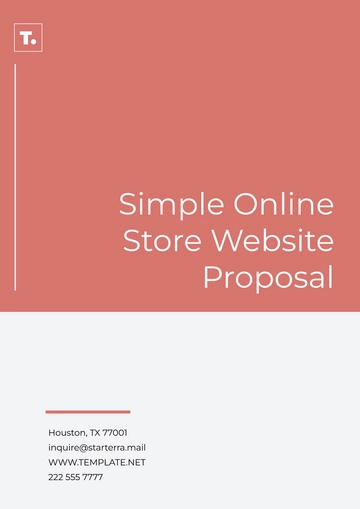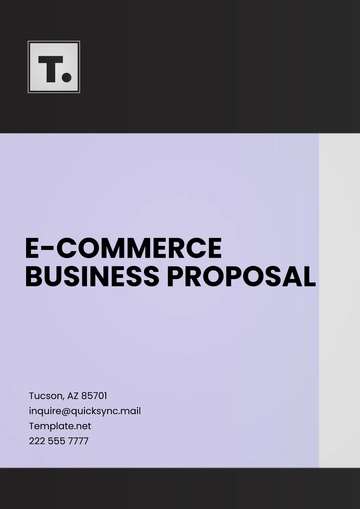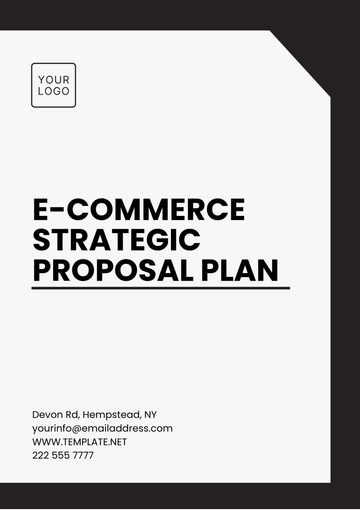Free E- Commerce Strategic Proposal Plan
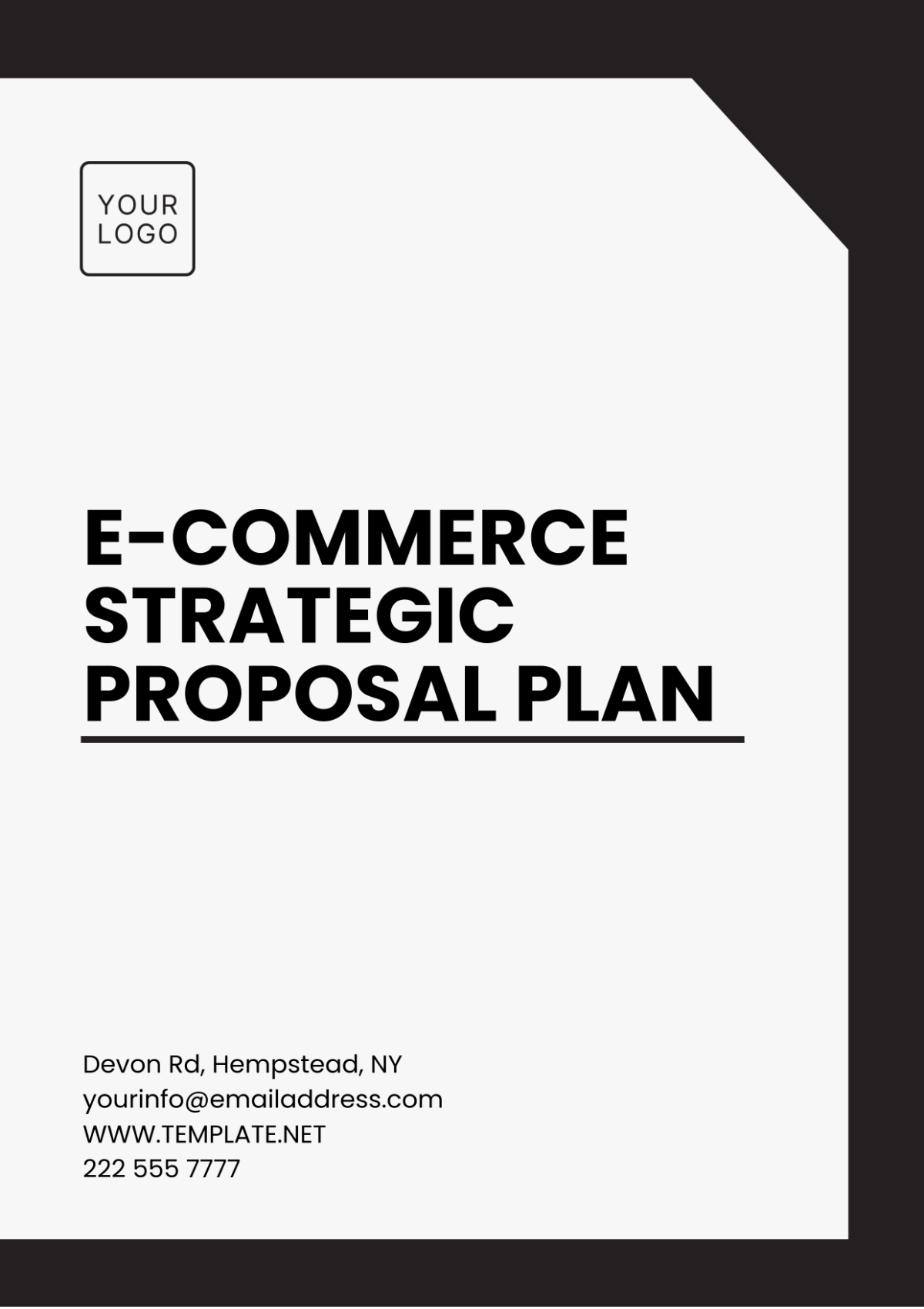
1. Executive Summary
[Your Company Name] aims to become a leading online retailer of eco-friendly products, catering to environmentally conscious consumers. This proposal outlines our strategic approach to enhancing our online presence, increasing market share, and achieving a projected revenue growth of 30% within the next two years. By leveraging innovative marketing strategies, optimizing our e-commerce platform, and enhancing customer experience, we intend to solidify our position in the rapidly growing green product market.
2. Business Overview
2.1 Company Background
Company Name: [Your Company Name]
Established: 2050
Industry: E-Commerce/Retail
Location: [Your Company Address]
2.2 Mission and Vision
Mission Statement: To provide high-quality, sustainable products that promote a healthier planet while making eco-conscious living accessible to everyone.
Vision Statement: To inspire and empower individuals to make environmentally responsible choices and contribute to a sustainable future.
3. Market Analysis
3.1 Industry Overview
The global e-commerce market for eco-friendly products is expected to grow at a compound annual growth rate (CAGR) of 15% from 2024 to 2030. Increased consumer awareness of environmental issues and the rise of sustainable living trends drive this growth.
3.2 Target Market
Demographics: Primarily targeting adults aged 25-45, with a balanced gender distribution, mostly middle to upper-middle-class income levels.
Psychographics: Consumers interested in sustainability, health-conscious living, and those actively seeking to reduce their carbon footprint.
3.3 Competitive Analysis
Competitor | Strengths | Weaknesses |
|---|---|---|
GreenMarket | Strong in product variety |
|
EcoShop |
|
|
[Your Company Name] |
|
|
3.4 SWOT Analysis
Strengths: High-quality products, commitment to sustainability, and a dedicated customer base.
Weaknesses: Limited marketing budget and brand recognition.
Opportunities: Growing demand for sustainable products and potential for partnerships with eco-conscious brands.
Threats: Intense competition and fluctuating supply chain costs.
4. E-Commerce Strategy
4.1 Goals and Objectives
Short-Term Goals:
Achieve a 15% increase in website traffic within the first year.
Enhance social media engagement by 25% through targeted campaigns.
Long-Term Goals:
Attain a 30% increase in online sales by the end of year two.
Expand product lines to include eco-friendly household items by year three.
4.2 Website Development
Platform Selection: Shopify will be used for its user-friendly interface and robust e-commerce capabilities.
User Experience (UX): Prioritize responsive design, easy navigation, and intuitive checkout processes to enhance customer satisfaction.
4.3 Marketing Strategy
SEO: Optimize content for eco-friendly keywords to enhance organic search visibility.
PPC: Launch Google Ads campaigns aimed at eco-conscious consumers.
Social Media Marketing: Leverage Instagram and Facebook for targeted ads and posts on sustainable living.
Content Strategy: Create a blog with articles on sustainability and product guides to boost engagement.
Influencer Partnerships: Collaborate with eco-conscious influencers to promote products and broaden brand reach.
4.4 Sales Strategy
Pricing Model: Implement competitive pricing strategies while highlighting product quality and sustainability.
Product Range: Offer a diverse range of eco-friendly products, including reusable bags, biodegradable utensils, and organic skincare items.
4.5 Logistics and Operations
Supply Chain Management: Partner with local suppliers who adhere to sustainable practices to minimize carbon footprint.
Shipping and Delivery: Offer free shipping on orders over $50, with eco-friendly packaging options.
Customer Service: Establish a dedicated support team available via chat, email, and phone to assist customers with inquiries.
5. Financial Projections
5.1 Revenue Model
Sales Forecast:
Year 1: $250,000
Year 2: $325,000
Break-Even Analysis: Expected to break even within 18 months, considering initial investments in marketing and website development.
5.2 Budgeting
Initial Investment: $50,000 allocated for website development, inventory acquisition, and marketing.
Ongoing Expenses: Monthly operational costs estimated at $5,000, covering hosting, marketing, and customer service.
6. Implementation Plan
6.1 Timeline
Milestone | Timeline | Details |
|---|---|---|
Launch | Q1 Year 1 | Launch website and initial marketing campaigns. |
First Review | Q2 Year 1 | Evaluate marketing effectiveness and website traffic. |
Product Expansion | Q4 Year 1 | Expand product lines based on customer feedback. |
6.2 Responsibilities
Team Roles:
E-Commerce Manager: Oversees the entire online sales strategy.
Marketing Specialist: Manages digital marketing and social media campaigns.
Customer Service Representative: Handles customer inquiries and support.
7. Evaluation and Metrics
7.1 Key Performance Indicators (KPIs)
Traffic Metrics: Targeting 5,000 monthly visitors by the end of Year 1.
Conversion Metrics: Aiming for a 3% conversion rate and reducing cart abandonment to below 50%.
Customer Metrics: Targeting a customer satisfaction score of 90% or higher.
7.2 Review Schedule
Quarterly Reviews: Assess performance against objectives, analyzing KPIs and adjusting strategies as needed.
8. Conclusion
The proposed e-commerce strategy for [Your Company Name] presents a clear and actionable plan to establish a strong online presence and drive sales growth in the eco-friendly market. With targeted marketing efforts, a user-friendly website, and a commitment to customer satisfaction, the business is well-positioned to achieve its objectives and contribute to a more sustainable future.
- 100% Customizable, free editor
- Access 1 Million+ Templates, photo’s & graphics
- Download or share as a template
- Click and replace photos, graphics, text, backgrounds
- Resize, crop, AI write & more
- Access advanced editor
Elevate your business strategy with the E-Commerce Strategic Proposal Plan Template from Template.net. This fully editable and customizable template enables you to present your e-commerce initiatives clearly and effectively. Utilize our AI Editor Tool for seamless adjustments, ensuring your proposal aligns with your unique vision and goals. Start crafting your strategic proposal today!
You may also like
- Business Proposal
- Research Proposal
- Proposal Request
- Project Proposal
- Grant Proposal
- Photography Proposal
- Job Proposal
- Budget Proposal
- Marketing Proposal
- Branding Proposal
- Advertising Proposal
- Sales Proposal
- Startup Proposal
- Event Proposal
- Creative Proposal
- Restaurant Proposal
- Blank Proposal
- One Page Proposal
- Proposal Report
- IT Proposal
- Non Profit Proposal
- Training Proposal
- Construction Proposal
- School Proposal
- Cleaning Proposal
- Contract Proposal
- HR Proposal
- Travel Agency Proposal
- Small Business Proposal
- Investment Proposal
- Bid Proposal
- Retail Business Proposal
- Sponsorship Proposal
- Academic Proposal
- Partnership Proposal
- Work Proposal
- Agency Proposal
- University Proposal
- Accounting Proposal
- Real Estate Proposal
- Hotel Proposal
- Product Proposal
- Advertising Agency Proposal
- Development Proposal
- Loan Proposal
- Website Proposal
- Nursing Home Proposal
- Financial Proposal
- Salon Proposal
- Freelancer Proposal
- Funding Proposal
- Work from Home Proposal
- Company Proposal
- Consulting Proposal
- Educational Proposal
- Construction Bid Proposal
- Interior Design Proposal
- New Product Proposal
- Sports Proposal
- Corporate Proposal
- Food Proposal
- Property Proposal
- Maintenance Proposal
- Purchase Proposal
- Rental Proposal
- Recruitment Proposal
- Social Media Proposal
- Travel Proposal
- Trip Proposal
- Software Proposal
- Conference Proposal
- Graphic Design Proposal
- Law Firm Proposal
- Medical Proposal
- Music Proposal
- Pricing Proposal
- SEO Proposal
- Strategy Proposal
- Technical Proposal
- Coaching Proposal
- Ecommerce Proposal
- Fundraising Proposal
- Landscaping Proposal
- Charity Proposal
- Contractor Proposal
- Exhibition Proposal
- Art Proposal
- Mobile Proposal
- Equipment Proposal
- Student Proposal
- Engineering Proposal
- Business Proposal
